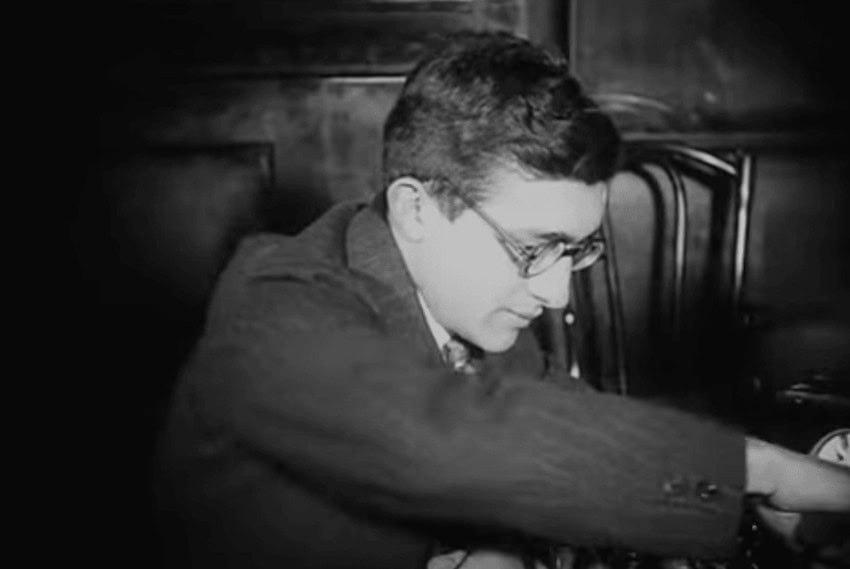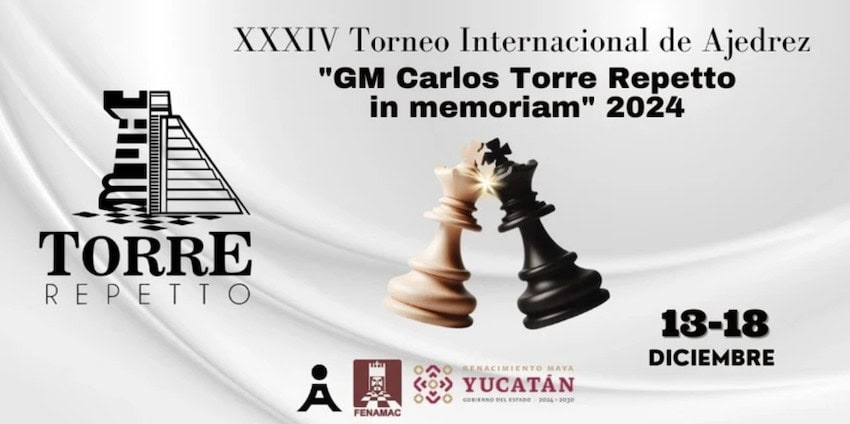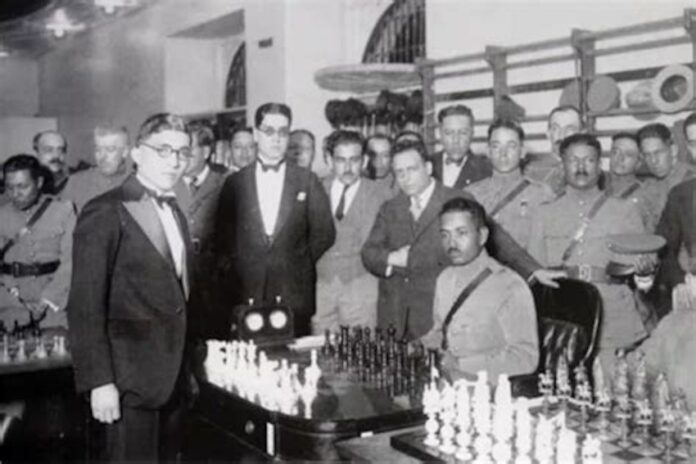While traveling aboard a Cunard liner to play in his first big European chess tournaments in March 1925, young phenom Carlos Torre Repetto kept his game sharp by playing with Frank Marshall, the man for whom the Marshall Chess Club in New York City was named and the then-reigning U.S. champion. In one still-legendary game from this trip, he beat Marshall in seven moves with the black pieces, an astonishing feat.
He had his moments at his first European tournament at Baden-Baden, Germany, against all the best players in the world but two: former world chess champion Emanuel Lasker, who held the title for 27 years, the longest reign in history, and the current champion, José Raúl Capablanca. But Torre was nervous, played too cautiously, and finished only 10th in a field of 21 players, despite a notable victory against Ernst Grünfeld, inventor of the Grünfeld Defense.

Carlos Torre became Mexico’s first chess Grandmaster in 1977, more than 50 years after his abrupt retirement. (Public Domain)
He started to find his form at the next tournament in Marienbad, Czech Republic, where he played with his more characteristic boldness and artistry. He finished tied for third with Marshall, defeated Grünfeld again, and during another of his thrilling victories, Aron Nimzowitsch, the man the Nimzowitsch Defense is named after, declared, “A new genius has arisen in the world of chess.”
The Mexican Immortal
That statement would prove prophetic at Moscow, in the then Soviet Union, where the first state-sponsored chess tournament in history was to be held. All the top players in the world were there, including Capablanca and Lasker. Torre drew against the former and won in 43 moves against the latter in a game so iconic it has also gone down in history as “The Mexican Immortal.”
Indeed, just as his miniature against Marshall aboard the Cunard ship Antonia would be canonized in chess lore as the Mexican Defense, his opening against Lasker would come to be known as the Torre Attack. This initial sequence, characterized by the moves d4, Nf3, Bg5 for white, helped to set him up in a great position. But it was his creative queen sacrifice on the 25th move that would enable a devastating windmill tactic that allowed his bishop-defended rook to lay waste to Lasker’s black defenses.
After this victory, which took place four days before his 21st birthday, Torre was famous in the chess world and would remain so even after a nervous breakdown the following year ended his career. Nearing the peak of his powers in Moscow, he would play in only two more tournaments, among which was a victory at Mexico’s national chess championship in Mexico City in 1926.

The remarkable rise of Carlos Torre
Born in Mérida, Yucatán, on November 29, 1904, Torre learned to play chess beginning at age six from watching his father, Egidio, and brother Raúl play. From this early stage, chess was a matter of fun for him. Later, when he started to become well-known for his abilities, he would see each game as a work of art. However, he always hated the competitive aspect, which was inevitably accompanied by unwelcome anxiety.
That competitive aspect became inevitable when he met Edwin Ziegler Adams, who became his mentor after his family moved to New Orleans when he was 12. By then, Torre’s talents were already apparent. He was so good within a few years of his arrival in New Orleans that no one wanted to play against him. By the age of 14, a local magazine hailed him as the second coming of Paul Morphy, a native New Orleanian who had dominated U.S. chess in the 1850s and was acknowledged as the world’s best player before abruptly retiring at age 22. In an odd twist of fate, Torre would retire at the same age.
However, that was still three years in the future when Torre, after winning the New Orleans city championship, won the Louisiana state chess championship in 1923. Seeking better players against whom to match his skills, he set his sights on New York, where he became a member of the Marshall Chess Club and went on to win that state’s championship in 1924. Marshall himself didn’t compete in that event, but as would later become apparent, on shipboard and in tournament play over the next two years, Torre was at least the equal of Marshall.
The only player then in New York (and indeed the entire U.S.) whom he probably wasn’t the equal of was Capablanca, the Cuban world champion whom he had yet to play against. But after Torre followed up his New York State Championship victory with a dominating performance in the Western Chess Association Championship in Detroit against the best players from around the U.S., winning 12 out of 16 games and drawing the other four, comparisons were being made. An issue of the American Chess Bulletin afterward was almost solely devoted to Torre, with his game compared to that of Capablanca.
It was this rapid rise that set the stage for Torre’s trip to Europe in 1925 and his immortal game against Lasker.
Torre’s abrupt retirement

Torre’s nervous breakdown in October 1926, nearly a year after he returned from his triumphs in Europe, has long been shrouded in mystery. One story has it that he broke down and began taking all his clothes off on a New York City bus. Another claims that his breakdown was brought on by being jilted by his fiancée for another man. Neither has ever been verified.
Torre himself, speaking more than 50 years after it occurred to Gabriel Velasco, who would later write “The Life and Chess Games of Carlos Torre: Mexico’s First Grandmaster,” said he was in fragile health due to dietary difficulties and was stressed out from being so far from home. The lack of dietary discipline — Torre often ate 12 pineapple ice cream sundaes in a single day — was likely a factor. So too was the lack of sleep, since he reportedly was only getting two hours per night.
After the breakdown, Torre quit tournament chess and returned to Mexico. He took a job in a pharmacy owned by his brother and was anonymous to all but chess players, who would often seek him out for advice. He spent his final years in a nursing home in Mérida, his hometown.
A legacy in chess
Although the Fédération Internationale des Échecs (FIDE) didn’t create the grandmaster title until 1950, nearly a quarter of a century after Torre played his last competitive games, the memory of his brilliancies remained. Thus, in 1963, FIDE awarded him the title of International Master (IM), and in 1977, it upgraded him to Grandmaster (GM) status, making him the first Mexican player to receive such an honor. Torre died soon after this announcement, in 1978, and it’s not known whether he ever knew about it.
But his legacy was secured and has only continued to grow thanks to the Torneo Internacional Carlos Torre Repetto, which since 1987 has been held annually in Mérida. Founded by physicist and philanthropist Alejandro Prevé Castro with the ambitious goal of raising the profile of chess in Mexico, it’s now considered one of the country’s finest tournaments, with the most recent iteration taking place in December 2024.
Chris Sands is the Cabo San Lucas local expert for the USA Today travel website 10 Best, writer of Fodor’s Los Cabos travel guidebook and a contributor to numerous websites and publications, including Tasting Table, Marriott Bonvoy Traveler, Forbes Travel Guide, Porthole Cruise, Cabo Living and Mexico News Daily. His specialty is travel-related content and lifestyle features focused on food, wine and golf.
